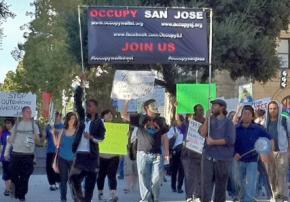Reports from Occupy: 10/31
The Occupy movement has spread from a small protest encampment in the financial district of Manhattan to a mass movement across the U.S.--and now the world--with supporters in over 1,000 cities, towns, campuses and more. Here, SocialistWorker.org is publishing reports we receive from activists around the country, describing the actions they're organizing and the discussions they're a part of. If you want to contribute a report, use this "Contact Us" page.
Silicon Valley
By Michael Chase
THE SILICON Valley cities of San Jose and Palo Alto have joined the Occupy Wall Street movement, bringing the struggle into the heart of high-tech wealth. Occupy San Jose has camped out in front of City Hall since October 2. The encampment is populated by folks from San Jose and other nearby communities.
San Jose's first Sunday General Assembly attracted 300 people. The South Bay AFL-CIO Labor Council endorsed the occupation the first week and brought supplies, but some at the encampment believe that support is contingent on their support of the labor council's Democratic Party candidates.
Occupy San Jose is producing its own paper. At a recent meeting, it was decided to create a Vietnamese translation to reach that large demographic.
The encampment was threatened by the authorities early on with a citation on the grounds that city ordinances prohibit them from staying beyond 11 p.m. Over the first three weeks, San Jose police handed out only a couple citations over the first three weeks. But later in October, the harassment began to increase.

Since October 20, San Jose police conducted three raids each in the early morning hours. The police arrested about a dozen members of Occupy San Jose. A protest was held October 21 opposing police harassment. On October 22, there were only three tents left. During a raid on October 26, one protester climbed a 60-foot wall where he remains holding a sign: "Stand up for what you believe in."
Also on October 22, during a meeting on FBI repression of Arab and Muslim communities that was held around the corner from City Hall, a call went out for those in attendance to show support for Occupy San Jose. This was important especially in light of the police raids. San Jose police revealed themselves and hopefully disabused anyone of the notion that men with shields and guns are on our side.
Occupy Palo Alto commenced October 12 with a protest outside of Bank of America on El Camino Real, which was organized by Peninsula Peace and Justice in solidarity with the Occupy demonstration. The turnout of 170 mostly older workers and retirees exceeded expectations. Horns honked in support nearly non-stop.
SocialistWorker.org is regularly rounding up reports sent to us from around the country, describing the actions of the Occupy movement and the political discussions activists are having.News of the Occupy movement
Near the end, e-mails were collected for a list of those interested in being a part of the Palo Alto General Assembly. The first meeting was held the following October 18, with about 30 people in attendance. Meetings as the first General Assembly will be held twice a week--Tuesday evenings and Sunday afternoon. An events committee was formed and participants discussed outreach to Occupy Stanford.
Columbus, Ohio
AN ESTIMATED 1,000 people occupied a large, public space known as "the Oval" on the campus of Ohio State University (OSU) in Columbus throughout the day on October 24.
The occupation lasted around five hours and culminated in a final march of around 100 students and faculty from campus to the Columbus City Council meeting downtown, where the group demanded, but were denied, a permit to occupy a public space in the city.
The campus event included a slate of student speakers involved with various activist organizations, including representatives from United Students Against Sweatshops, the Graduate Employee Student Organization, Committee for Justice in Palestine and the campus branch of the International Socialist Organization, showcasing the coalitional feel of the campus movement.
Ohio State student Alicia Miklos attended the event because she hoped to become connected to other students who felt inspired to create change by focusing first and foremost on corporate greed. Miklos said:
There are so many things that need to be fixed, but I know they're all connected. The corporations are the key problems. They broke the unions. They are messing up the environment. They have their hands in everything.
The event also included a teach-in, featuring faculty members from across the university, and an hourly reading of the OSU Educators Statement of Support, a statement signed by dozens of faculty to support the student-led occupation.
Students also wrote grievances to university president Gordon Gee, to be delivered to his office by a student delegation later this week.
While students expressed their solidarity with the Occupy Wall Street protesters throughout the day, most emphasized their concern for campus-specific issues, including the recent privatization of traffic and parking services on campus, the mistreatment of campus staff and graduate employees, and a plan which may change Ohio State's status from a public university to a charter university within the next year. According to protesters, Ohio State has become a leader among public universities in the trend toward privatization.
Speakers also included activists and organizers from outside the university, including John Carlos, the 1968 Olympic medalist who raised his fist in a Black Power salute, and several labor representatives, including a contingent from the Communications Workers of America and the Student/Farmworker Alliance. The diversity of speakers represented major gains toward student/labor/community solidarity in the larger Occupy Columbus movement.


